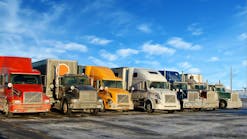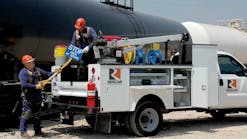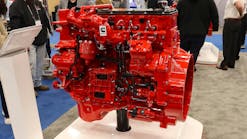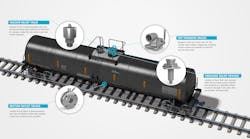The world relies on chemicals to provide the essentials of modern life and they are the basic building blocks of everyday items; from the fertilizers that help grow our food to the beds we lie on, from the shoes on our feet to the cars that we drive. Transporting those chemicals safely to where they are needed, is a major logistical effort that requires advanced sealing technology.
To give some perspective, the American Chemistry Council’s 2021 Guide to the Business of Chemistry estimates that 946 million tons of products were transported in 2020, making the business of chemistry one of the country’s largest shippers. According to the Association of American Railroads, chemical, petroleum, and petroleum product freight accounted for around 20% of total North American rail carloads during 2019, equating to just over 68,700 carloads on average per week.
With end users of chemicals spread across five continents, the safe transport of huge volumes of materials to production plants by rail, road, sea, or air is itself a massive industry. In the U.S. alone, ACC says that some 970 million tons of chemicals shipped around the country in 2018. Regardless of the type of chemical, producers and consumers need safe, efficient, and cost-effective methods of transportation.
The solution at the heart of any chemical transport system is a tank. Pumping substances into a tank prior to them being sent to their destination and emptying at the destination involves pumps and valves containing a variety of seals. It is crucial to ensure that chemicals do not leak into the environment; zero-leakage is mandatory to avoid environmental contamination and meet strict regulations. Seals must perform well for a long time, regardless of how destructive chemicals may be.
Ensuring safety
Intrinsically, the type of chemicals transported will cause standard sealing materials to deteriorate prematurely with the most aggressive of media being extremely destructive.
Consequently, chemical transporters worldwide rely on seal manufacturers, like Trelleborg Sealing Solutions, with extensive materials expertise to provide specialized reliable sealing solutions, service, and technical support. This will prevent non-accidental releases (NARs) and ensure the safe and efficient operation of tank cars, tank trucks, ISO containers, and IBC equipment.
Reducing the total cost of ownership
Though the seals themselves are relatively low in value, the labor to bring the tank into the shop and perform maintenance, lost up-time during maintenance, and time spent waiting for an inspector to sign off on work done, can be costly. The key to lowering the total cost of ownership for the tank operator is increasing seal life to extend the mean time between maintenance.
In addition, to make transportation as effective and economical as possible for the carrier, it’s ideal to use the same pump, valves, and seals regardless of the media transported.
For this to be possible, the seal materials must be resistant to the maximum number of chemicals that are potentially transported and be able to withstand a wide range of operating temperatures. Consider, for example, the challenging environmental conditions when traveling across deserts in extreme heat or over ice fields at low temperatures. This seemingly makes universal sealing across the full range of chemicals potentially transported an almost unsurmountable task.
Material solutions make their mark
When transporting certain commodities, the only possible type of sealing materials are Perfluoroelastomers (FFKMs), which exhibits the sealing qualities of an elastomer combined with the chemical resistance of a Polytetrafluoroethylene (PTFE). However, not all FFKMs are created equally.
Special properties are needed to stand up to the harshest of chemicals likely to be transported. For example, Trelleborg developed a proprietary FFKM compound it says can effectively endure the rigorous conditions faced in chemical transportation over the broadest range of media, proving their effectiveness by subjecting them to an extensive testing program involving the 16 most transported chemicals. This includes MTBE.
Methyl Tert Butyl Ether (MTBE) is an additive for ethanol that is a denaturant, preventing the consumption of ethanol as an alcohol, which allows it to be de-taxed by the U.S. government. Also, under the Sulphur 2020 initiative, higher-grade diesel is replacing previously prevalent bunker fuel, and this has MTBE in it. These factors are increasing the number of shipments of ethanol and diesel with added MTBE.
MTBE is extremely destructive to sealing materials and few compounds can provide extended life in this chemical. This makes the use of a single tank pump impossible. Trelleborg says its new sealing materials can stand up to MTBE and other chemicals, which could make them a “game changer” for tank operators in lowering total cost of ownership.
Conclusion
Chemical companies and shippers value component partners who know that chemical transportation is not just about the seals themselves and their chemical compatibility; service is also a critical factor. Avoidance of downtime is vital. When equipment requires repair, commodities aren’t moving, and the equipment owner and shipper is losing money. That’s why they should look for solutions and materials that offer the best and broadest resistance to transported media, optimum seal reliability in both extreme hot and cold conditions, and extended service life, all leading to a lower cost of ownership.









